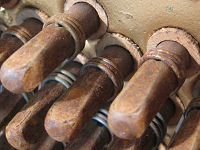
For a piano to maintain a stable tuning and sound its best, it is essential that the tuning pins are tight and that the strings are in good condition. If the tuning pins of a piano become loose and tend to slip, the piano will not stay in tune for a reasonable amount of time. If the strings have deteriorated to the point where they are breaking frequently, the tone of the piano will most likely suffer as well. If your piano has problems caused by brittle strings and loose pins, these issues could be lessened or eliminated if your piano were to be repinned and restrung.
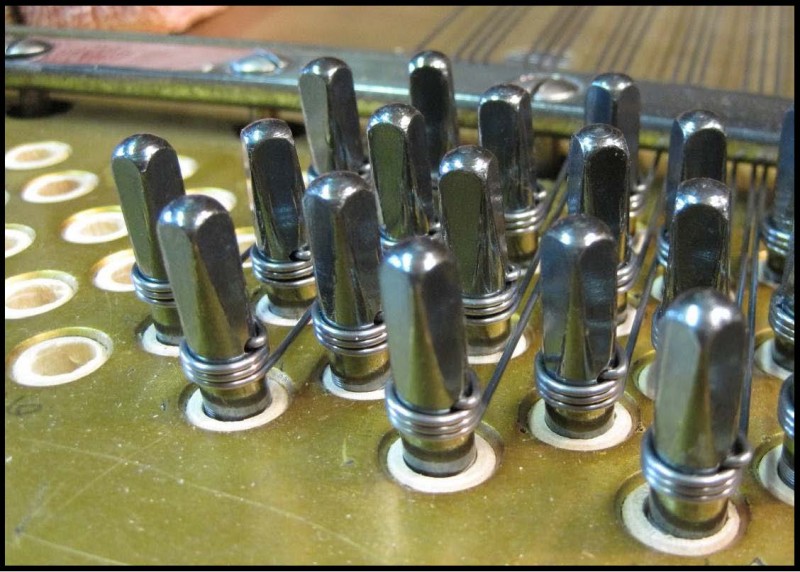 New tuning pins and strings being installed.
New tuning pins and strings being installed.
What factors would cause the tuning pins of a piano to loosen up to the point where they do not hold?
The problem with loose pins actually has more to do with the condition of the pinblock than the pins themselves. The pinblock is typically a 1 1/2″ thick plank, consisting of laminations of hardwood (typically hardrock maple) that grip each pin tightly. The holes for the tuning pins are drilled smaller (approximately 1/100″) than the pins, but as the piano ages the pinblock tends to dry out and shrink up slightly, causing the pins to have less than ideal torque. If this condition exists in your piano, replacing the factory installed pins with slightly oversized pins is one highly effective way to bring the torque of the pins back to what the piano had when it was new.
What are the symptoms of loose pins?
Most obvious is the presence of individual notes that are wildly out of tune with themselves, indicating that pins are slipping. Each treble note has three strings, and the upper bass strings usually have two, so when one pin slips, the strings aren’t matched and they produce a raucous sound.
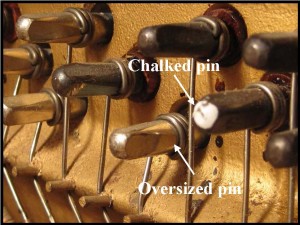 A quick glance inside the piano will sometimes confirm the condition. If the tops of tuning pins have been marked with chalk (photo), that is a sign that tuners in the past have noticed pins which were unlikely to hold. Also, pins that look out of place, shinier or larger in circumference than the rest, indicate that previous technicians have tried to address the problem. In that loose pins usually don’t develop overnight, this is evidence that the problem has been ongoing for some time.
A quick glance inside the piano will sometimes confirm the condition. If the tops of tuning pins have been marked with chalk (photo), that is a sign that tuners in the past have noticed pins which were unlikely to hold. Also, pins that look out of place, shinier or larger in circumference than the rest, indicate that previous technicians have tried to address the problem. In that loose pins usually don’t develop overnight, this is evidence that the problem has been ongoing for some time.
What are the symptoms of a set of strings that are ready for replacement?
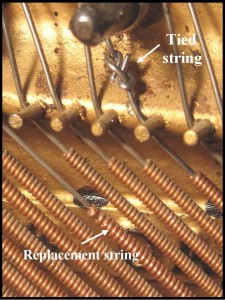 The most obvious sign that strings need to be replaced is a history of breakage. If the piano is missing a number of strings, or if there are strings which have been replaced or tied (both seen in photo at left), then the set of strings is most likely due for replacement. Rusty strings and pins (cover photo) should also be considered candidates for replacement. A poor sound may also be the result of a set of strings which is past its prime. Bass strings which are tubby sounding, or treble strings with a less than satisfactory tone may be in need of replacement, even if they are not brittle or rusty.
The most obvious sign that strings need to be replaced is a history of breakage. If the piano is missing a number of strings, or if there are strings which have been replaced or tied (both seen in photo at left), then the set of strings is most likely due for replacement. Rusty strings and pins (cover photo) should also be considered candidates for replacement. A poor sound may also be the result of a set of strings which is past its prime. Bass strings which are tubby sounding, or treble strings with a less than satisfactory tone may be in need of replacement, even if they are not brittle or rusty.
What factors cause the strings of a piano to deteriorate?
First of all, piano strings are made from high-carbon steel, and as such are susceptible to rusting, especially in climates of high humidity. When rust attacks the strings of a piano, not only is the tonal quality of the strings affected but breakage is much more likely to occur as well. Piano strings typically have 150 or more pounds of tension on them, and they wind their way around various friction points. With this amount of tension and strain, it is understandable that the added problem of corrosion will spell trouble.
Even when rust is not present, steel string may become brittle with age and suffer from simple metal fatigue. Bass strings have copper windings over their steel cores, which is another problem area. These copper windings are put on at tension, and tend to lose their vibrancy over the decades, becoming “tubby” sounding.
For a piano that has problems with loose pins or overtaxed strings, are there other options less costly than a total job of repinning and restringing?
Yes, there are other options, some of which are less time-consuming and not as expensive, but also some that are more. For a piano with a shot pinblock, the more complete job of pinblock replacement, followed by the installation of both new pins and new strings may be the best option. For a piano which has problems with loose pins only, treatment with C.A. glue may be an option to consider. Sometimes very satisfactory results may be obtained in terms of pin torque without having to resort to the pulling out and replacing of every pin. Likewise, if the problem with poor string quality is strictly in the bass of the piano, replacing just the bass strings would be an option as well.
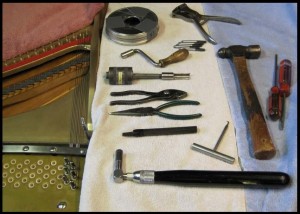 However, if both loose pins and poor quality strings are problematic, it really does make sense to do the two jobs at the same time. Both jobs are very labor-intensive, requiring the picking up and laying down of a dozen or more hand tools for each of the 230 or so pins and strings of the piano. By combining the two jobs, a more efficient use of time allows for a savings in cost over doing one job first, followed by the other job at a later time.
However, if both loose pins and poor quality strings are problematic, it really does make sense to do the two jobs at the same time. Both jobs are very labor-intensive, requiring the picking up and laying down of a dozen or more hand tools for each of the 230 or so pins and strings of the piano. By combining the two jobs, a more efficient use of time allows for a savings in cost over doing one job first, followed by the other job at a later time.
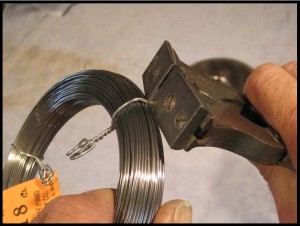 Copper wound bass strings are special-ordered to match the original strings found in the piano. If the piano is a well-known brand and model, the stringing company will be able to produce the new set using information on file. If the data isn’t available, however, the old strings will need to be sent to the stringing company for duplication.
Copper wound bass strings are special-ordered to match the original strings found in the piano. If the piano is a well-known brand and model, the stringing company will be able to produce the new set using information on file. If the data isn’t available, however, the old strings will need to be sent to the stringing company for duplication.
Treble wire, on the other hand, is purchased by the technician in rolls of precise thicknesses to match what the piano originally had. Wire is available in sizes graduated in 1/1000th of an inch increments starting from the thinnest of .029″ to the thickest of .049″. (The 18-gauge wire shown has a thickness of .041″). Precision measurement and duplication of wire sizes is necessary to ensure that the tonal quality of the completed restringing job is what it should be.
What about tuning pins? Are they a specialty item?
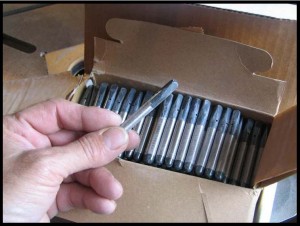 Tuning pins are a stock piano replacement part sold in sets. They are made from high-quality steel cut with micro-threads and are produced with extremely consistent diameter. Typically, the next size up from the factory set (which would be .004″ larger) will be installed to give a tighter fit. Tuning pins do come in two finishes, blued (shown in photo) and nickle plated.
Tuning pins are a stock piano replacement part sold in sets. They are made from high-quality steel cut with micro-threads and are produced with extremely consistent diameter. Typically, the next size up from the factory set (which would be .004″ larger) will be installed to give a tighter fit. Tuning pins do come in two finishes, blued (shown in photo) and nickle plated.
With a completely new set of strings, both bass and treble, and new pins as well, your piano would maintain a much more stable tuning and would have a sound that would be closer to the piano’s potential. If your piano is having issues with the problems as described, having the appropriate work done would be an investment which would pay dividends in terms of the enhanced performance of your instrument.
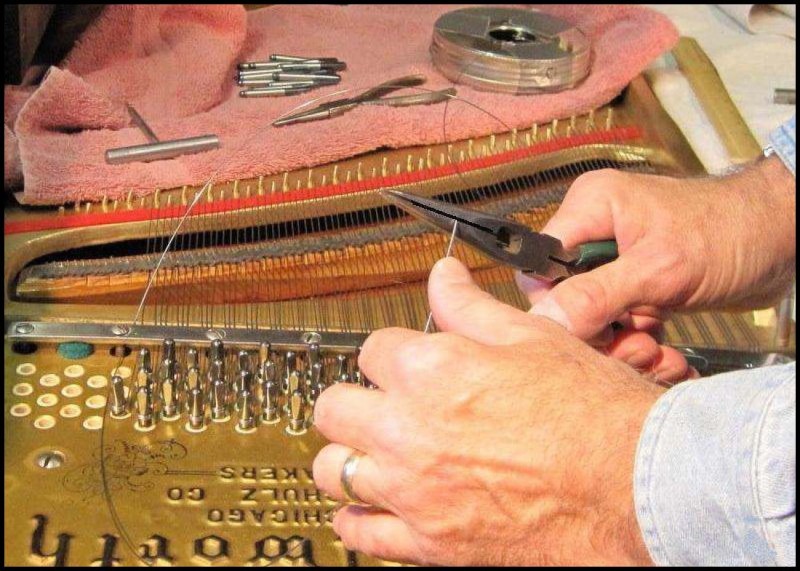 Work in progress on a restringing / repinning job.
Work in progress on a restringing / repinning job.